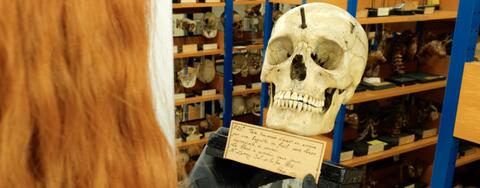Facial reconstruction: A multidisciplinary study at Sorbonne University restores the face of a Napoleonic soldier
A research project involving the Sorbonne University's Library and the Institute of Computing and Data Sciences (ISCD) has created in the reconstruction of the face of one of Napoleon's soldiers. Based on a skull preserved in the Dupuytren pathological anatomy collections, the project is a true investigation, using a multidisciplinary approach and innovative scientific techniques that combine 3D photogrammetric digitization with historical and archival research. This collaboration, which has also revealed the soldier's identity, is part of an ethical approach to "de-anonymizing" individuals and personal stories.
-
Katherine Tyrka, international press service, Sorbonne University
-
+33 (0)1 44 27 51 05
-
Rémi Gaillard, Deputy Director of the Sorbonne University Library, in charge of the Scientific Collections and Heritage Department
-
+33 (0)1 44 27 51 94
-
Eloïse Quétel, Head of Sorbonne University's medical collections and artistic heritage
-
+33 (0)1 44 27 91 91
Now housed at Sorbonne University, the Dupuytren pathological anatomy collection includes several thousand bone pieces, fluid specimens and anatomical waxes. Among them is the skull of a Napoleonic soldier who died in March 1806, a few days after having his forehead accidentally pierced by a rifle ramrod; this skull is officially named Christophe Cros, according to written records. The spectacular nature of the wound, as well as the fact that the rod miraculously touched no vital functions, helped make this case famous. It was studied by Dominique-Jean Larrey, a pioneer of "battle surgery" who, as surgeon-in-chief of the Grande Armée under the Empire, was present on most of the battlefields of Napoleon 1st's military campaigns.
"This skull is an emblematic piece of the pathological anatomy collections of the former Dupuytren Museum, and has acquired a certain celebrity in the history of medicine and neuroscience," explains Éloïse Quetel, curator-restorer of human remains and organic materials, in charge of medical collections and the Dupuytren collection at Sorbonne University.
This multi-disciplinary project involving the Sorbonne University Library, preserves the university's scientific collections, and the ISCD, was launched in 2022 to reconstruct the soldier's face and recover his identity.
Starting with a 3D photogrammetric scan of the skull, and based on an innovative scientific method, scientific visualization engineers from ISCD proposed a rigorous reconstruction of the face in the form of a 3D digital mesh. The Mesh to Metahuman software was then used to refine the representation of the face, taking advantage of new photo-realistic rendering functionalities.

on the right, the reconstruction of his face obtained by the ISCD © Sorbonne University
In parallel, historical and archival research carried out by teams from the Scientific Collections and Heritage Department of the Sorbonne University Library led to the hypothesis that the skull could be that of Stapham Grosse, a young Alsatian carpenter from Hartmannswiller (Haut-Rhin), conscripted in November 1805 and aged just 21 at the time of the accident. The physical description on his service record, as well as iconographic research and exchanges with museums holding collections of First Empire artworks and artefacts, enabled us to further characterize the face and physiognomy of a typical Napoleonic soldier.
Mobilizing the expertise of different profiles (engineer, curator, historian, anthropologist, ballistics expert, etc.) and an innovative digital reconstruction method, the project is also part of an ethical approach to "de-anonymizing" the individuals and personal trajectories represented in Sorbonne Université's pathological anatomy collections, made up of thousands of human remains.
"This is a major project, because it involves the application of cutting-edge, contemporary scientific methods to a historical piece, enabling us to delve deeper into the science and history dimension, which is now being mobilized enough in museum institutions to show the contribution of new technologies and scientific methods to specimens such as this one. I also see a memorial dimension in the way we manage the Dupuytren collections and the issues they raise", concludes Rémi Gaillard, Deputy Director of the Sorbonne University Library, in charge of the Scientific Collections and Heritage Department.
A documentary and a round table
A documentary entitled "Qui es-tu Christophe Cros ?"
(Who are you Christophe Cros?), produced by Sorbonne University's Communications Department, plunges viewers into the heart of this investigation. The film was shown on November 22, 2023 during a cine-debate moderated by journalist Daniel Fiévet, in the presence of six experts:
- Rémi Gaillard, Deputy Director of the Sorbonne University Library, in charge of the Scientific Collections and Heritage Department
- Éloïse Quetel, curator-restorer of human remains and organic materials, in charge of medical collections and the Dupuytren collection at Sorbonne University
- Chloé Bertolus, Professor at Sorbonne University, Head of the Maxillofacial Surgery Department at Pitié-Salpêtrière Hospital
- Jacques-Olivier Boudon, Professor of Contemporary History at Sorbonne University, Research Center in 19th century History
- Nicolas Leys, scientific visualization engineer, Institute of Computing and Data Sciences, Sorbonne University
- Cyrille Le Forestier, archaeoanthropologist, the French National Institute for Preventive Archeological Research – Inrap
See the documentary:
Qui es-tu Christophe Cros ? (documentary, automatic subtitles in English available)

